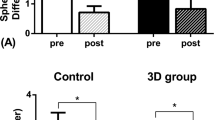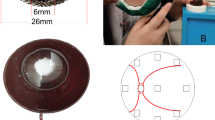Abstract
Purpose
This study aims to design an eye model that can simulate the fundus for teaching direct ophthalmoscopy and to evaluate its effectiveness.
Methods
We first used 3D printing materials to make an eye model and then randomly assigned 92 undergraduates into group A (model-assisted training group) and group B (traditional training group) to test our model. After the same training time, real patients were used to test the students, with 120 s as the examination time limit. We recorded the students’ ability to clearly see the optic disk, the time to determine the cup-to-disk ratio, and whether they were correct.
Results
Forty-three students in group A (93.48%) successfully saw the fundus, while 21 in group B (45.65%) succeeded. The difference between the two groups was 47.83% (95% confidence interval, 29.59–66.07%, P < 0.0001). The median time to see the fundus was 29s (95% confidence interval 23–45 s) in group A, while an estimated minimum time in group B was 80 s, indicating that group A was significantly faster than group B (P < 0.0001).
Conclusions
This 3D-printed eye model significantly improved the students’ study interest, study efficiency, and study results and is worthy of being promoted.





Similar content being viewed by others
Availability of data and material
All data are available upon request from the corresponding author
Code availability
Not applicable
References
Chadha N, Gooding H (2021) Twelve tips for teaching ophthalmology in the undergraduate curriculum. Med Teach 43:80–85. https://doi.org/10.1080/0142159X.2020.1758649
Shah M, Knoch D, Waxman E (2014) The state of ophthalmology medical student education in the United States and Canada, 2012 through 2013. Ophthalmology 121:1160–1163. https://doi.org/10.1016/j.ophtha.2013.12.025
Quillen DA, Harper RA, Haik BG (2005) Medical student education in ophthalmology: crisis and opportunity. Ophthalmology 112:1867–1868. https://doi.org/10.1016/j.ophtha.2005.05.005
Orlans HO (2016) Direct ophthalmoscopy should be taught within the context of its limitations. Eye (Lond) 30:326–327. https://doi.org/10.1038/eye.2015.225
Katherine M, Michael W (2019) Direct ophthalmoscopy. Soon to be forgotten? Ulster Med J 88:115–117
Mottow-Lippa L (2009) Ophthalmology in the medical school curriculum: reestablishing our value and effecting change. Ophthalmology 116:1235–1236, 1236 e1231. https://doi.org/10.1016/j.ophtha.2009.01.012
Dyer C (2017) Court overturns optometrist's conviction for gross negligence manslaughter. BMJ 358:j3749. https://doi.org/10.1136/bmj.j3749
Benbassat J, Polak BC, Javitt JC (2012) Objectives of teaching direct ophthalmoscopy to medical students. Acta Ophthalmol 90:503–507. https://doi.org/10.1111/j.1755-3768.2011.02221.x
Chan TY, Rai AS, Lee E, Glicksman JT, Hutnik CM (2011) Needs assessment of ophthalmology education for primary care physicians in training: comparison with the International Council of Ophthalmology recommendations. Clin Ophthalmol 5:311–319. https://doi.org/10.2147/OPTH.S17567
Hull CW (1986) Apparatus for production of three-dimensional object by stereolithography. In: U.S. Patent 4, 330. (ed).
Takahashi K, Morita Y, Ohshima S, Izumi S, Kubota Y, Yamamoto Y, Takahashi S, Horii A (2017) Creating an optimal 3D printed model for temporal bone dissection training. Ann Otol Rhinol Laryngol 126:530–536. https://doi.org/10.1177/0003489417705395
Hao J, Nangunoori R, Wu YY, Rajaraman M, Cook D, Yu A, Cheng B, Shimada K (2018) Material characterization and selection for 3D-printed spine models. 3D Print Med 4:8. https://doi.org/10.1186/s41205-018-0032-9
Reymus M, Fotiadou C, Hickel R, Diegritz C (2018) 3D-printed model for hands-on training in dental traumatology. Int Endod J 51:1313–1319. https://doi.org/10.1111/iej.12947
Adams F, Qiu T, Mark A, Fritz B, Kramer L, Schlager D, Wetterauer U, Miernik A, Fischer P (2017) Soft 3D-printed phantom of the human kidney with collecting system. Ann Biomed Eng 45:963–972. https://doi.org/10.1007/s10439-016-1757-5
Perica ER, Sun Z (2018) A systematic review of three-dimensional printing in liver disease. J Digit Imaging 31:692–701. https://doi.org/10.1007/s10278-018-0067-x
White SC, Sedler J, Jones TW, Seckeler M (2018) Utility of three-dimensional models in resident education on simple and complex intracardiac congenital heart defects. Congenit Heart Dis 13:1045–1049. https://doi.org/10.1111/chd.12673
Pujol S, Baldwin M, Nassiri J, Kikinis R, Shaffer K (2016) Using 3D modeling techniques to enhance teaching of difficult anatomical concepts. Acad Radiol 23:507–516. https://doi.org/10.1016/j.acra.2015.12.012
Wong NC, Hoogenes J, Guo Y, Quantz MA, Matsumoto ED (2017) Techniques: utility of a 3D printed bladder model for teaching minimally invasive urethrovesical anastomosis. Can Urol Assoc J 11:E321–E322. https://doi.org/10.5489/cuaj.4262
Spinelli D, Marconi S, Caruso R, Conti M, Benedetto F, De Beaufort H, Auricchio F, Trimarchi S (2019) 3D printing of aortic models as a teaching tool for improving understanding of aortic disease. J Cardiovasc Surg. https://doi.org/10.23736/S0021-9509.19.10841-5
Famery N, Abdelmassih Y, El-Khoury S, Guindolet D, Cochereau I, Gabison EE (2019) Artificial chamber and 3D printed iris: a new wet lab model for teaching Descemet's membrane endothelial keratoplasty. Acta Ophthalmol 97:e179–e183. https://doi.org/10.1111/aos.13852
Chung KD, Watzke RC (2004) A simple device for teaching direct ophthalmoscopy to primary care practitioners. Am J Ophthalmol 138:501–502. https://doi.org/10.1016/j.ajo.2004.04.009
Akaishi Y, Otaki J, Takahashi O, Breugelmans R, Kojima K, Seki M, Komoda T, Nagata-Kobayashi S, Izumi M (2014) Validity of direct ophthalmoscopy skill evaluation with ocular fundus examination simulators. Can J Ophthalmol 49:377–381. https://doi.org/10.1016/j.jcjo.2014.06.001
Ting DS, Sim SS, Yau CW, Rosman M, Aw AT, Yeo IY (2016) Ophthalmology simulation for undergraduate and postgraduate clinical education. Int J Ophthalmol 9:920–924. https://doi.org/10.18240/ijo.2016.06.22
Ricci LH, Ferraz CA (2017) Ophthalmoscopy simulation: advances in training and practice for medical students and young ophthalmologists. Adv Med Educ Pract 8:435–439. https://doi.org/10.2147/AMEP.S108041
Custers EJ, Ten Cate OT (2011) Very long-term retention of basic science knowledge in doctors after graduation. Med Educ 45:422–430. https://doi.org/10.1111/j.1365-2923.2010.03889.x
Littlewood KE (2011) High fidelity simulation as a research tool. Best Pract Res Clin Anaesthesiol 25:473–487. https://doi.org/10.1016/j.bpa.2011.08.001
Gupta RR, Lam WC (2006) Medical students’ self-confidence in performing direct ophthalmoscopy in clinical training. Can J Ophthalmol 41:169–174. https://doi.org/10.1139/I06-004
Acknowledgements
The authors appreciate the support from Professor Chunhua Hu and Mr. Xuzhen Du in the Department of Aerospace Engineering of Tsinghua University for providing 3D materials and guiding the establishment of the eye model.
Funding
1. Young Medical Education Scholar Program of Peking Union Medical College (2017zlgc0704)
2. Undergraduate Education Reform Program of Peking Union Medical College (2017zlgc0123)
3. The Non-profit Central Research Institute Fund of Chinese Academy of Medical Sciences (2018PT32029)
Author information
Authors and Affiliations
Corresponding author
Ethics declarations
Ethics approval and consent to participate
Waived by the Peking Union Medical College Hospital Review Board because of the non-clinical nature of the study. Informed consent was obtained from all individual participants included in the study.
Conflict of interest
The authors declare no competing interests.
Additional information
Publisher’s note
Springer Nature remains neutral with regard to jurisdictional claims in published maps and institutional affiliations.
Rights and permissions
About this article
Cite this article
Wu, C., Luo, M., Liu, Y. et al. Application of a 3D-printed eye model for teaching direct ophthalmoscopy to undergraduates. Graefes Arch Clin Exp Ophthalmol 260, 2361–2368 (2022). https://doi.org/10.1007/s00417-021-05538-w
Received:
Revised:
Accepted:
Published:
Issue Date:
DOI: https://doi.org/10.1007/s00417-021-05538-w




